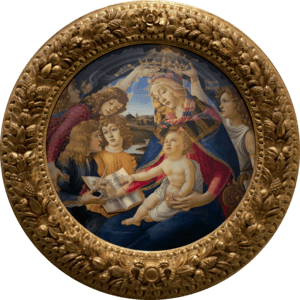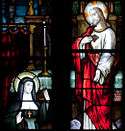Sanctuary of Our Lady of Lourdes

The Sanctuary of Our Lady of Lourdes or the Domain (as it is most commonly known) is an area of ground surrounding the Catholic shrine (Grotto) to Our Lady of Lourdes in the town of Lourdes, France. The Sanctuary is a destination for pilgrimage; sick pilgrims are reputed to be miraculously healed by Lourdes water. This ground is owned and administrated by the Roman Catholic Church, and has several functions, including devotional activities, offices, and accommodation for sick pilgrims and their helpers. The Domain includes the Grotto itself, the nearby taps which dispense the Lourdes water, and the offices of the Lourdes Medical Bureau, as well as several churches and basilicas. It comprises an area of 51 hectares, and includes 22 separate places of worship.[1] There are six official languages of the Sanctuary: French, English, Italian, Spanish, Dutch and German.
Grottos intended as replicas of the one at Our Lady of Lourdes, and other grottos in honour of Our Lady of Lourdes, are often described as "Lourdes grottos".
History
Beginning on 11 February 1858, a 14-year-old peasant girl named Bernadette Soubirous claimed to have experienced a series of apparitions of a girl dressed in white and with a blue belt around her waist, who eventually introduced herself as the Immaculate Conception, a name by which the Virgin Mary was known.
On land bordered by a loop of the Gave de Pau river is an outcrop of rock called Massabielle, (from masse vieille: "old mass"). On the northern aspect of this rock, near the river bank, is a naturally occurring, irregularly shaped shallow cave or grotto, in which the apparitions took place.[2]
At the time of the apparitions, the grotto lay well outside town, on common ground which was used by the villagers variously for pasturing animals, collecting firewood, and as a garbage dump, and it had a reputation for being an unpleasant place.[3]
The figure always appeared in one place, a niche above the main cavity of the grotto, in which a wild rose bush was growing. Among the instructions from 'the Virgin' were "Go and drink from the spring", "Go and tell the priests to build a chapel here", and "Have the people come here in procession". These three instructions in particular were to prove pivotal in the development of the Domain and its ceremonies.
Public interest in the apparitions grew, and curious visitors began to be replaced by pilgrims from increasingly far away, drawn by compelling stories of apparitions and miracles.
A local priest, Abbé Dominique Peyramale, together with his bishop, Monsignor Bertrand-Sévère Mascarou Laurence, bought the grotto and the land around it from the commune in 1861, 3 years after the apparitions. Immediately they set about modifying the area to make it more accessible to visitors, and started work to build the first of the churches, which is now known as the Crypt.
In 1864, the Lyonnais sculptor Joseph-Hugues Fabisch was commissioned to create a statue of Our Lady of Lourdes based on Bernadette's descriptions. Although it has become an iconic symbol of Our Lady of Lourdes, it depicts a figure which is not only older and taller than Bernadette's description, but also more in keeping with orthodox and traditional representations of the Virgin Mary. The statue rests in the niche where the Virgin appeared to Bernadette. The original wild rose bush was destroyed shortly after the apparitions by pilgrims seeking relics, but a newer one has been planted nearby.[4]
Due to French political upheaval resulting in an enforced separation of Church and State, the property and grounds of the Domain were confiscated from the Church and returned to the ownership of the town in 1910. The then bishop, Mgr. François-Xavier Schoepfer, contested this confiscation, and was permitted to rent the Domain from the town until the outbreak of World War I in 1914.[5]
Later, a visit to Lourdes by Marshal Pétain in 1941 provided official recognition of the Domain. Church officials successfully petitioned Pétain to allow the Church to reclaim ownership of the Domain.[5]
Administration
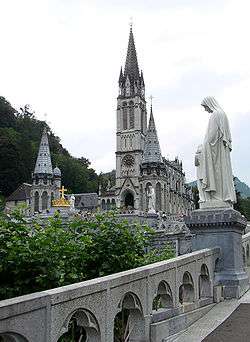
The Bishop of Tarbes and Lourdes is responsible for the spiritual governance of the Domain. He appoints a local representative, who is called the Rector. The Domain is run independently of the parish of Lourdes, which is responsible for the spiritual needs of the Lourdais themselves.
Thirty full-time chaplains work in the Domain, from dioceses and religious communities worldwide. As of 2010 there were 292 full-time lay employees and a further 120 seasonal employees working in 63 different divisions, with an annual running budget of €18 million, 90% from donations.[6]
The Domain is open all year round. In winter there are many fewer visitors, a reduced timetable of services and devotional activity, and no processions. The winter season runs from 1 November (the feast of All Saints) until Easter.[7] On 11 February, the Feast of Our Lady of Lourdes, a full programme of activities usually takes place.
The Domain is fully active between Easter and All Saints each year, and has a programme of devotional activities including Mass, processions (see below), Adoration of the Blessed Sacrament, and the Sacrament of Reconciliation. Many activities are carried out in several languages; in some services the liturgy is repeated in different languages.
The grounds are open daily from 5 am until midnight;[8] outside these times the Grotto is accessible via the Lacets Gate behind the Upper Basilica.
An estimated 200 million people have visited the shrine since 1860 . The Roman Catholic Church has officially recognized 67 miracle healings, the 67th of which was the cure of Anna Santaniello in 1952, recognised on 9 November 2005.
About 800 tonnes of wax is burnt annually in devotional candles.[4]
The Domain publishes the monthly Lourdes News, with news and featured articles about the Domain and Lourdes generally.
Lourdes water
Lourdes water flows from a spring at the same spot where it was discovered by Bernadette. The original spring can be seen within the Grotto, lit from below and protected by a glass screen.
Pilgrims drink Lourdes water due to its reputed healing power. The water from Lourdes was thoroughly analysed by independent chemists in 1858 and 1859, and does not appear to have a latent power to cure and has no special scientific or medicinal properties. Despite this, the water is itself a strong symbol of devotion for Lourdes pilgrims, and many buy statues and rosary beads containing small vials of it, and take home large plastic containers of it.
Baths
Each year about 350,000 pilgrims bathe in the water at the baths (Piscines).[9] During the pilgrimage season, the baths are open 8.30 am-12.30 pm / 1.30 pm-6.00 pm on weekdays and 10.00 am-12.00 noon / 2.00 pm-4.00 pm Sundays and Holidays,
Processions
Processions are held in the Domain, with the Torchlight Procession being perhaps the best-known and most visually impressive
Blessed Sacrament procession
The Blessed Sacrament procession is held daily at 5.00pm. The procession begins at the open-air altar in the Prairie, and is usually led by a priest or bishop carrying a monstrance containing the Blessed Sacrament. Typically the bearer of the Blessed Sacrament is sheltered from the elements by a mobile awning/canopy, called a baldachin, carried by four assistants.
The exact order of the procession varies from time to time. The Blessed Sacrament may be preceded by bearers carrying leafy branches, incense burners or other devotional items. These bearers are usually lay people who may be invited specially. The Blessed Sacrament is usually followed by a group of priests who concelebrate the rite. Following these are groups of pilgrims, usually under a group banner, and in no particular order, although larger groups tend to dominate the procession near the front.
The procession makes its way across the Gave, alongside the ramps, and past the Crowned Statue, along the Esplanade to the Cross at the far end, and then around it, and down into the Underground Basilica (where participants may be seated). Pilgrims in wheelchairs are brought to the front in each case.
During the procession there are meditations, prayers, hymns and chants, in several languages. When all the participants have assembled, there follows a period of Eucharistic Adoration, and the Blessing of the Sick.[10]
Torchlight Procession
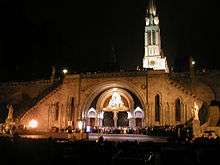
The Torchlight Marian Procession takes place daily at 9.00pm. It begins outside the Grotto and follows the same route as the Blessed Sacrament Procession. In extreme weather an indoor ceremony may be held in the Underground Basilica instead.
The procession is led by pilgrims bearing a replica of the Cabuchet Statue of the Virgin Mary. As before, groups usually proceed together under their group banner. Most participants carry a candle with a paper shade which diffuses the light and makes the candle less likely to blow out.
The focus of this procession is the rosary. All five decades are recited, usually in a variety of languages. The Lourdes Hymn is also sung, with verses in different languages. Intercessions may be invoked followed by the Laudate Mariam. There is a final blessing in Latin, and then an invitation to exchange the Sign of peace with fellow pilgrims.[11]
Main churches of the Domain
Crypt
The Crypt was the first of the churches to be completed in the Domain, and is today among the smallest. Construction was started by Abbé Peyramale and Mgr. Laurence. Bernadette's father worked on its construction and was present at its official opening, on Pentecost Sunday, 1866.
The nave is small and a notable feature are the enormous pillars which support the weight of the Upper Basilica, which was constructed on top of it.
The Crypt is entered along a corridor, whose entrance is dominated by a large bronze statue of St. Peter, holding the Keys of the Kingdom of Heaven. Opposite stands a statue of Pius X. The walls of the corridor and nave are lined with small marble plaques, known as ex voto plaques, donated in thanks of spiritual favours received.[12]
Upper Basilica
The Basilica of the Immaculate Conception, known widely as the Upper Basilica, was the second of the churches to be completed, consecrated in 1876. It is an impressive, elaborate building in Gothic style, designed by architect Hyppolyte Durand, and on one side seems to emerge directly from the rock of Massabielle (the sanctuary is directly above the Grotto). The walls are lined with ex voto plaques, and banners from official National Pilgrimages of the past. It has a series of stained-glass windows depicting various events in the story of Lourdes; the clerestory windows depict Mary as the Second Eve.
The exterior is dominated by a 70m spire, and two lesser spires (not completed until 1908). Above the entrance is a mosaic depicting Pope Pius IX, who defined the dogma of the Immaculate Conception in 1854.[13]
Rosary Basilica
The Rosary Basilica is the third of the churches to be completed, in 1899 and designed by architect Leopold Hardy. It was consecrated in 1901 and has a capacity of 1,500 worshippers. Its style is influenced by Byzantine architecture. The nave is open and circular, surmounted by a dome. The exterior of the dome is surmounted by a dramatic gilded crown and cross, which were a gift from the people of Ireland in 1924.
The exterior facade of the basilica was modified in 2007 to include a depiction of the Luminous Mysteries, which were added to the traditional fifteen by Pope John Paul II in 2002.
Crowned Statue and Rosary Square

The open space in front of the Rosary Basilica is known as Rosary Square.
The entrances to the Crypt and the Upper Basilica, both of which are built on top of Massabielle, are far above ground level. To facilitate access, two enormous ramps were constructed, which curve down either side of Rosary Square. The image of the entrance of the Rosary Basilica, flanked by the two ramps and surmounted by the spires of the Upper Basilica, has become one of the iconic symbols of Lourdes, and a stylised form of this image has been adopted by the Domain itself as its logo.
The Statue of the Crowned Virgin, often known as the "Crowned Statue" (French: La Vierge Couronnée), stands across Rosary Square from the Rosary Basilica and faces the entrance. This prominent statue is a familiar landmark and a traditional meeting point. The statue is 2.5m high and cast in bronze, painted white and blue in the traditional colours. Her rosary is of the Birgittine style and incorporates six decades.[4]
Behind the Crowned Statue is the Esplanade, a large open walkway which is used in the processions.
Underground Basilica
The Basilica of St. Pius X, known as the Underground Basilica, is the largest and most controversial of the Domain's churches. It was designed by the architect Pierre Vago and completed in 1958 in anticipation of the enormous crowds expected in Lourdes for the centenary of the Apparitions. A modern, concrete building, it is almost entirely underground (part of the building lies beneath the Boulevard Père Rémi Sempé above). When full it can accommodate 25,000 worshippers.
Church of St. Bernadette
The most recent of the major centres of worship is the Church of St. Bernadette, which was consecrated in 1988. It was built opposite the Grotto across the Gave, on the spot where Bernadette stood during the final (18th) Apparition.
The Church of St. Bernadette is a modern building with comparatively little adornment. It was designed to allow as much natural light as possible into the nave, and light-coloured materials have been used, making it noticeably brighter than the Underground Basilica. It was designed by the architect Jean-Paul Felix.
It is also a more versatile building. The nave has provision for 5,000 seated worshippers and 350 wheelchairs, but partitions can be drawn which divide the nave into smaller sections. In addition, it includes the Hemicycle, a large lecture room which may be used for worship, and an assortment of conference rooms and smaller rooms which may be used for devotional or non-devotional activity.[14]
Chapel of Reconciliation
The Chapel of Reconciliation formerly occupied a site slightly more remote, at the entrance of the Upper Stations of the Cross. It was moved several years ago into a more prominent position, into the building previously known as the Accueil Notre Dame, near the Crowned Statue and facing the Esplanade.
The Chapel of Reconciliation is somewhat unusual in that no masses or other services take place there; instead it is given over entirely to the Sacrament of Reconciliation. Priests from different countries observe a duty roster, which means that, at almost any time of day, pilgrims from Europe (and occasionally further away) can find a priest who will hear their confession in their own language.
St. Joseph's Chapel
St. Joseph's Chapel is situated at the far end of the Esplanade, near St. Michael's Gate. It is a modern, concrete church, mostly underground, with little natural light. It was also designed by Pierre Vago, and was consecrated on 1 May 1968. It has provision for 450 seated worshippers and 80 wheelchairs.[15]
Grotto

In contrast to the grandness of Rosary Square and the various basilicas, the grotto at Massabielle where St Bernadette's visions took place is very simple and stark. The recess of the grotto itself is undecorated, although a plain stone altar and lectern have been placed there so that Mass can be said. Above the main recess is the niche where the apparitions took place and Fabisch's statue now stands. A large stand of candles next to the altar is kept burning during the season.
The spring Bernadette is said to have dug can be seen at the rear of the grotto, shielded by a glass cover. Pilgrims can process through the grotto and it is traditional to touch the rocks directly under the statue; indeed so many people have done this that the stones have become polished. Also at the rear of the grotto is a metal box into which written prayers or petitions may be deposited; they are collected daily and burnt.
Rows of benches allow visitors to sit and pray or contemplate. Pilgrims are asked to remain silent while in the vicinity to create an atmosphere of devotion. One of the spots where Bernadette prayed to the Virgin is marked by a special paving slab.
Some of the rock walls around the grotto bear clear signs of deliberate alteration, presumably to improve access for pilgrims. It is no longer clear what the original configuration of the grotto was.
At least one contemporary account describes a series of chambers behind the statue's niche, which can only be reached by climbing "like a lizard" through clefts in the rocks.[16]
Accueils and hospitals

Across the river from the grotto and the churches is the Accueil Notre Dame, a modern facility built in 1996 to house sick pilgrims during their time in Lourdes.
The Accueil Notre Dame was built to replace the two older Accueils that were present within the Domain. The old Accueil Notre Dame stood opposite the Underground Basilica, and has been extensively remodelled, being divided into two buildings by removing a section. One building now contains the Chapel of Reconciliation, which used to be the refectory, and also houses the convent of the Sisters of Charity of Nevers. The other section is now known as the Accueil John Paul II, and contains several chapels (e.g. St Cosmos & St Damien), the First Aid post and Dispensary, and the offices of the Hospitalité. The other was the Accueil St. Bernadette, which stood across the river from the old Accueil Notre Dame, and was demolished to make way for the new one.
Since Easter 1997 sick pilgrims from all over the world have been housed in the Accueil Notre Dame, an airy modern building. The Accueil is organised into two wings, each consisting of six storeys, with the Reception area on the ground floor and the Transit Lounge on the fifth. Each floor from one to four is named after a specific saint, with female saints honoured on one side and male ones on the other. Each floor has a central refectory area where pilgrims congregate to eat.
The rooms, each with bathroom and shower, accommodate from one to six people. Each room has a window, with some fortunate ones having a view of the Grotto, and storage cupboards and a table and chairs. Each room opens onto a communal area.
Linking the two sides is the Administration Area, with two panoramic lifts bringing visitors to each floor. The administration offices are on the sixth and seventh floors, and there are kitchens for each side.
Typically pilgrims arrive at the Accueil Notre Dame in buses from Lourdes airport or train station, and will be welcomed in the transit lounge on the 5th floor. From there they are taken to their rooms. Pilgrims also depart from the transit lounge.
Another accueil, the Accueil Marie St. Frai, is located a short distance outside the domain; it is similar in design and atmosphere to the Accueil Notre Dame.
Prairie
Across the Gave from the Grotto is a wide, open, uncluttered space covered with grass and known in French as the 'prairie, or in English, the meadow.
In the corner of the prairie is the tent-like Chapel of Adoration, consecrated in 1995 and given over entirely to veneration of the Blessed Sacrament, and there is an open-air altar for outdoor ceremonies in fine weather.
In 2002 the Water Walk was introduced, across the Gave and slightly downstream from the Grotto. It consists of a series of nine stations at which there is a small Lourdes water font.
Candles and Brulières
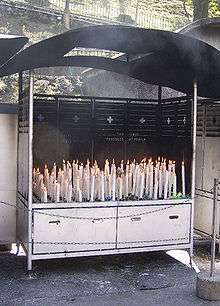
A further iconic image of Lourdes is the tall, conical stand containing votive candles which are burnt constantly in the Grotto. Pilgrims may purchase candles (white, with a blue base) to be burnt here as a devotional gesture, or bring their own. Candles of many different sizes may be burnt in the Domain; the largest are two metres tall and require more than one person to lift them—such candles are usually bought by groups of pilgrims, and typically burn continuously for over a week.
For safety as well as convenience, candles are burnt together in large metal stands called brulières. Pilgrims may light their own candles, or leave candles to be burnt later. The brulières are tended by feutiers, attendants whose job is to ensure candles are burnt safely and evenly, and to remove the trays of melted wax which collects under each brulière.
Scepticism and criticism
Since the earliest of the Lourdes apparitions, there has been intense debate regarding their veracity. The earliest investigators, including the priest Abbé Dominique Peyramale and the Chief of Police, Dominique Jacomet, were both initially convinced they were dealing with a hoax (each later changed his mind), and several researchers have since called several aspects of the Lourdes phenomenon into question.
The apparitions at Lourdes took place against the backdrop of a rich network of popular piety, which was common throughout the Pyrenean region in the 19th century. In the decades leading up to 1858, several children in small Pyrenean villages (on both sides of the border) claimed to see apparitions of the Virgin Mary in remote locations. Many consider that Bernadette was simply repeating a well-tried trick to gain attention and notoriety. Believers argue that this is not likely, since Bernadette claimed the Lady called herself "the Immaculate Conception", referring to a doctrine formally established only four years previously, and which Soubirous may not have been familiar with.[17]
Modern Lourdes contains numerous souvenir shops. Some visitors may dislike the commercialism of parts of Lourdes, with neon-emblazoned shops overflowing with what Malcolm Muggeridge, a supporter of the shrine, called "tawdry relics, the bric-a-brac of piety".[18] Lourdes has been called the "Disneyland of the Catholic Church". Critics argue that the Lourdes phenomenon is nothing more than a significant money-spinner for the town and the region, which therefore has a strong vested interest in keeping the pilgrims coming.[19] The church, however, distances itself from commercialisation. The many trinket stalls are privately owned, and hawkers are strictly forbidden inside the sanctuary.
Many people remain sceptical about Lourdes and its supposed healing power, arguing that any improvement offered by the shrine is no more than the placebo effect, and that the ceremonies and processions are no better than faith-healing on a grand scale.
Similar history as Our Lady of Guadalupe in Mexico
The origin of this large church complex inspired by a vision in France is similar to the origin of the Basilica of Our Lady of Guadalupe in Mexico. Bernadette Soubirous's vision of 1858 which gave rise to the growth of Lourdes is similar to the case of Juan Diego's vision in 1531 in Mexico. Both saints reported visions in which a miraculous lady on a hill asked them to request that the local priests build a chapel at the site of the vision. Both visions had a reference to roses. Like Our Lady of Lourdes in France, Our Lady of Guadalupe is a major Catholic symbol in Mexico and the Basilica of Our Lady of Guadalupe complex is one of the largest and most visited Catholic churches in the Americas, but does not have the specific reputation for healing that Lourdes has.
See also
References
- ↑ http://www.lourdes-france.org/index.php?goto_centre=ru&contexte=en&id=431&id_rubrique=431
- ↑ Ruth Harris, Lourdes: Body and Spirit in the Secular Age, Penguin Books, 1999, p. 52.
- ↑ Ruth Harris, Lourdes: Body and Spirit in the Secular Age, Penguin Books, 1999, p. 53.
- 1 2 3 Oliver Todd, The Lourdes Pilgrim, Matthew James Publishing, 2003, p. 41.
- 1 2 Ruth Harris, Lourdes: Body and Spirit in the Secular Age, Penguin Books, 1999, p. 365.
- ↑ Lourdes website: The Domain, accessed 17 March 2010
- ↑ Oliver Todd, The Lourdes Pilgrim, Matthew James Publishing, 2003, p. 52-3.
- ↑ Oliver Todd, The Lourdes Pilgrim, Matthew James Publishing, 2003, p. 77.
- ↑ http://www.lourdes-france.org/index.php?goto_centre=ru&contexte=en&id=434
- ↑ Oliver Todd, The Lourdes Pilgrim, Matthew James Publishing, 2003, p. 151.
- ↑ Oliver Todd, The Lourdes Pilgrim, Matthew James Publishing, 2003, p. 155.
- ↑ Oliver Todd, The Lourdes Pilgrim, Matthew James Publishing, 2003, p. 42-3.
- ↑ Oliver Todd, The Lourdes Pilgrim, Matthew James Publishing, 2003, p. 43.
- ↑ Oliver Todd, The Lourdes Pilgrim, Matthew James Publishing, 2003, p. 45.
- ↑ Oliver Todd, The Lourdes Pilgrim, Matthew James Publishing, 2003, p. 46.
- ↑ Ruth Harris, Lourdes: Body and Spirit in the Secular Age, Penguin Books, 1999.
- ↑ Francis Trochu. Saint Bernadette Soubirous:1844-1879. Pantheon. pp. 156–158.
- ↑ Muggeridge contrasts the "tawdry relics, the bric-a-brac of piety" with the spiritual phenomena he describes experiencing in Lourdes. (Jesus Rediscovered, A Visit To Lourdes, Fontana 1969.
- ↑ "Consuming Visions—Mass Culture and the Lourdes Shrine, Suzanne Kaufman", Book reviewed by Lawrence S. Cunningham University of Notre Dame, Commonweal 23 September 2005.
External links
| Wikimedia Commons has media related to Sanctuary of Our Lady of Lourdes. |
- The official Domain website, which includes maps and webcams
- The cures at Lourdes recognised as miraculous by the Church (PDF)
Coordinates: 43°05′51″N 0°03′30″W / 43.09750°N 0.05833°W
